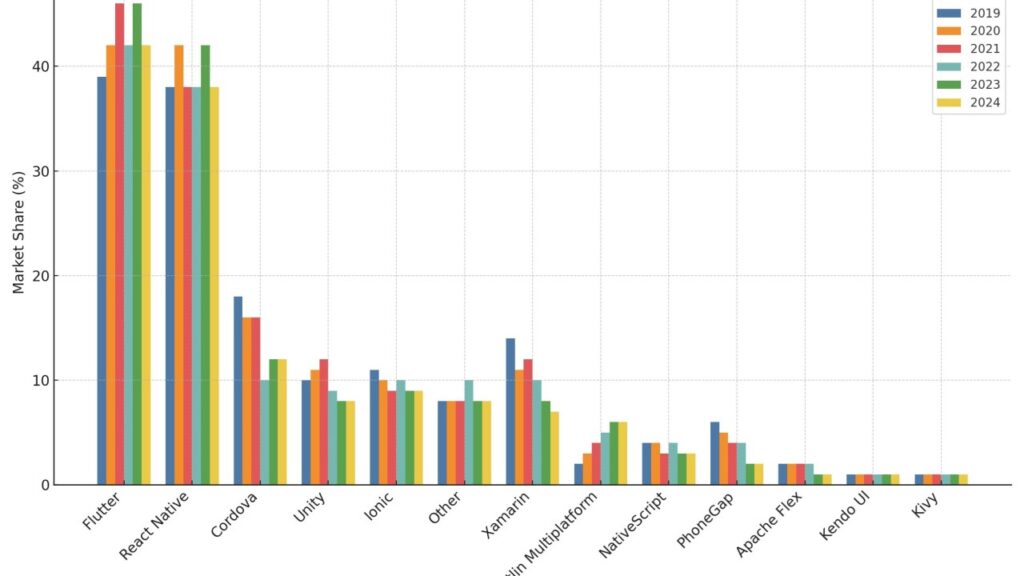At ByteCraft Labs, we continuously analyze emerging trends in mobile application development to deliver innovative solutions to our clients. This article highlights the evolution of popular mobile app usage and Mobile platform Usage and Market Share (2019–2024), reflecting significant shifts in developer preferences and technology adoption.
Visual Overview
The bar chart below showcases the market share trends of leading Mobile Platform Usage and Market Share from 2019 to 2024. It vividly highlights the rise of modern cross-platform frameworks like Flutter and React Native and the decline of older technologies. For more information click here!

Key Insights of Mobile Platform Usage
1. Continued Dominance of Flutter and React Native
Flutter and React Native remain at the forefront of mobile development frameworks, sustaining their strong positions.
- Flutter: Gained a market share of approximately 47% in 2024, demonstrating steady growth due to its comprehensive UI toolkit and robust community.
- React Native: Maintained a consistent market share of around 41% in 2024, emphasizing its reliability and strong ecosystem.
2. Decline of Legacy Frameworks
Older frameworks like Cordova and PhoneGap continued to lose market share, marking a developer transition toward modern solutions.
- Cordova: Declined from 18% in 2019 to below 8% by 2024, showcasing a substantial reduction in adoption.
3. Growth of Kotlin Multiplatform
Kotlin Multiplatform has shown steady growth, reaching approximately 12% in 2024. Its promise of shared code between mobile and backend applications resonates with developers seeking efficiency and scalability.
4. Niche but Stable Platforms
Certain frameworks have retained niche positions:
- Unity: Widely used for game development, remains a leader in its domain.
- Ionic: Continued to cater to web-centric applications.
- Xamarin: Experienced further decline as developers shifted to .NET MAUI.
5. Minimal Adoption of Peripheral Frameworks
Frameworks like Kendo UI and Kivy remained at minimal adoption levels, reflecting limited traction among mainstream developers.
Conclusion
The data for 2024 reaffirms the industry trend toward modern, versatile, and high-performance cross-platform frameworks. Flutter‘s steady growth and React Native‘s robust hold demonstrate developers’ preference for frameworks enabling rapid development and native-like experiences. The decline of legacy technologies highlights a clear shift toward tools that provide better performance, developer experience, and community support.
At ByteCraft Labs, we leverage such insights to deliver future-ready solutions tailored to our clients’ needs. By staying attuned to technological advancements, we ensure our services empower businesses to achieve their goals seamlessly.

Your insights are magical! Have you experienced Sprunki Incredibox? It’s magical creation.
This is pure creativity! While creating magic, Sprunki Phase creates endlessly.